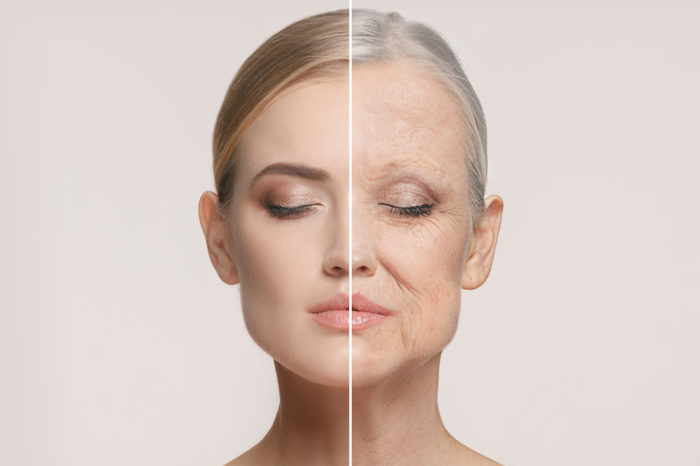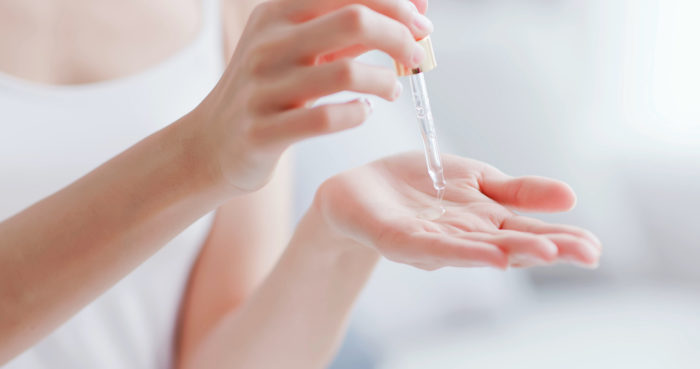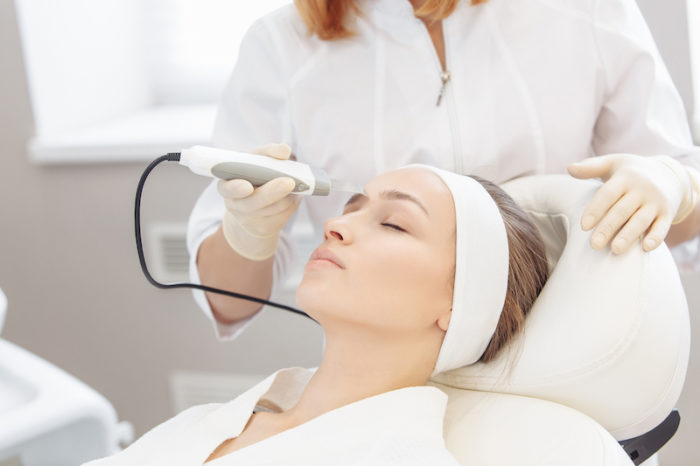Uncategorized
RIGHT TIME AND RIGHT WAY TO SUPPLEMENT CERAMIDE FOR ANTI-AGING EFFECTS
In this article
- Reasons for ceramide loss in human skin
- Right time to start supplementing ceramide
- Right ways to supplement ceramide (oral & topical)
Reasons for ceramide loss in human skin
Inner causes
Main causes for depletion natural subcutaneous Ceramide volume may include :
1. Natural Aging
 Photo 1. Gradual natural loss of Ceramide from the age of 20 Photo 1. Gradual natural loss of Ceramide from the age of 20 | According to the study on the effects of aging and weather on epidermal lipids , after 20 years of age, we shall suffer the natural loss of 10-15% of Ceramide volume every 10 years. In addition, a loss of approximately 30% of the total amount of epidermal lipids (including Ceramide) has a negative effect on metabolism of keratinocyte. It slows down the metabolism of keratinocyte, which impairs natural synthesis and regeneration of the skin. |
2. Nutrition
| Essential free fatty acids such as Linoleic Acid (LA) and Arachidonic Acid (AA) are important fatty acids in the synthesis of ceramides with long chain of carbons and deficiency of these fatty acids can disrupt the process of forming other important lipids at the skin epidermis. An extreme, unbalanced diet will easily lead to the deficiency of these important free fatty acids. |
|
3. Spiritual life and sleep
 Photo 3. Stress, lack of sleep | Stress related to psychosocial problems and lack of sleep disrupt the intrinsic protective function of the women’s skin. This disruption of skin function caused by stress has negative effects on the secretion of cytokines and cell chemokines, which is an important response of the body to damage and infections on the body. |
External causes
1. Cosmetic treatments, cosmetic chemicals
| Exposure to treatments or cosmetic products that contain substances such as acetone and ethanol weakens the skin’s protective functions as these ingredients impair lipids: CHOL, cholesterol ester, essential fatty acids, sphingolipids. In addition, like acetone, therapies or products that contain petroleum-based ingredients (or oils) also impair the skin’s protective function, but to a lesser extent. It is due to the decline of polar lipids (amphiphilic lipids) which are mainly phospholipids (the composition of cell membranes), sphingolipids and sterols. |
2. Weather conditions and sunlight exposure
| The research on the seasonal variation of epidermal lipids levels shows that in the summer, subcutaneous lipid levels are much higher and gradually decrease in the spring, sharply decreasing in the winter.
Specifically, the sharp decrease in the rate of CER (EOS) linoleate and CER (EOS) oleate causes the skin to lose moisture, elasticity and peel easily.
|  Photo 5. Exposure to sunlight has a negative effect on Ceramide |
Right time to start supplement ceramide
 Photo 6.Ceramide supplement should be started at age 20 Photo 6.Ceramide supplement should be started at age 20 | Starting at age 20, natural subcutaneous ceramide has begun to decline. In conditions when skins are healthy and properly taken care of, there’s a natural loss of 10-15% of Ceramide every 10 years. Therefore, from the age of 20 onwards, it is a good time to start considering ceramide supplement to prevent inner premature wrinkle formation. |
Right ways to supplement ceramide
Supplementing Ceramide by drinking and eating
1. Natural food source
Eat a full range of natural food sources rich in free fatty acids like olive [the oil source contains a lot of oleic acid]. In addition, tubers – the material for many of Japanese women’s favorite foods – are also a natural food source that supports ceramide synthesis, and importantly, does not cause weight gain.

2. Dietary supplement
There are many supplements and functional foods on the market that supplement essential fatty acids and chemical radicals for the synthesis of Ceramide. However, the supplements and functional foods should not be considered as top choices since the body needs the most natural source of nutrients to be balanced and naturally healthy.
 Photo 8. Ceramide supplements derived from peaches bring about safe and good effects. Photo 8. Ceramide supplements derived from peaches bring about safe and good effects. | A study on 26 healthy adults [average age of 47, 13 men, 13 women] showed the fact that glucosylceramide derived from peaches (Prunus persica) is consumed at 0.6mg / day and 1.2mg / day for 20 consecutive days helps to safely increase the amount of subcutaneous ceramide and improve subcutaneous moisture, resulting in smoother skin texture as well.
|
In addition, other plant-derived ceramide supplements such as rice, wheat, corn, and tubers are safe and offer similar effects to peach-derived ceramides.
Supplementing Ceramide by skincare products
1. What kind of skin needs the supplement of Ceramides?
Ceramide is suitable for all skin types, especially sensitive skin, dry and aging ones.
There are some assumptions that ceramide worsens the condition of clogged pores, which makes itself unsuitable for skins with acne, inflammation, swelling and redness. It is also cases in which using skincare products containing ceramides causes allergy and more pimples that makes ceramide rumored to be bad and totally unsuitable for sensitive skin or acne one.
Therefore, it is necessary to carefully choose reputable brands and learn more about their ingredients. Manufacturers of prestigious brands will use more reliable technology and material sources for synthesis of ceramide. In fact, there is little ceramide in natural resources; therefore, extracting ceramide is very expensive and costly.
All ceramides in skin-care products are synthesized ones. Therefore, technology, brand reputation and quality will determine the effectiveness of ceramide when externally applied.

2. Which technology helps Ceramide penetrate deepest into the skin most?
Can Ceramide penetrate into Stratum Corneum and perform its functions?
As known about the role of Ceramide in the skin, the deficiency of ceramide [natural or external effects] is a major cause of skin-related diseases. Therefore, researchers and cosmetics manufacturers have come up with a way to replace the deficiency of ceramide.
Ceramide’s ability to penetrate through the skin has caused a lot of controversy between two viewpoints that Ceramide cannot penetrate into the skin but stays on the skin surface, helping the skin become moisturized. It is because Ceramide’s large molecular structure and its lipid structure are difficult to penetrate through the skin epidermis.
Currently, the research and technology solutions to improve the absorption of nutrients through the skin epidermis are continuously updated. In particular, in regards to skin care products including Ceramide moisturizers, there are two methods of putting nutrients through the skin from popular creams: Conventional Carrier Systems and Novel Carrier Systems.
Although studies prove that the formula of ceramide combined with other easily penetrating nutrients such as oleic acid with the technology of Conventional Carrier Systems helps restore the skin’s protective functions, this technology cannot make Ceramide actually penetrate into the stratum corneum.
Regarding Novel Carrier System, researchers have found more advanced methods: vesicular systems, microemulsions, and nanoparticles to solve the difficulties in Ceramide’s penetration into the skin. In particular, the method of microemulsion – briefly translated as: micro emulsion is considered to be the most effective. In addition, the scientists said the “droplet size” in micro-emulsions or nano-emulsion is the key to Ceramide’s penetration into the skin.

Accordingly, a research shows that the type of oil in the emulsification step affects the droplet size of Ceramide. The largest droplet size can be found in emulsion formulas of avocado oil or oleic acid whereas the smallest droplet size can be found in the formula of Squalane.
Hence, for emulsifying Ceramide creams with emulsifying technology (microemulsion or nanoemulsion) can penetrate deepest into the skin. And the Squalane ingredient in the emulsifying formula gives the smallest droplet size, which enhances the penetration of Ceramide through the skin.
3. Which ingredients in cosmetic formulations help to optimize the effectiveness of Ceramide?
The perfect ratio of epidermal lipid structure is ~ 50% ceramide, ~ 25% cholesterol, ~ 15% free fatty acid. Skin- care products containing ceramide will be the most effective when they are of these ingredients.
Therefore, several cosmetic ingredients which can help optimize the effectiveness of a ceramide-based cream are: cholesterol and free fatty acids. And the ratio of Ceramide: Cholesterol: the free fatty acid in the product is adjusted to best suit the skin’s natural ratio. When this ratio reaches the most natural level, it will bring more lasting moisturizing and restoring effect
In addition, for better anti-aging effect and wrinkle treatment, ceramide-rich cream contain antioxidant ingredients.

Mirokal Timeless Repair Cream containing Ceramide 1,3,6 with golden ratio 12%. SEE MORE














